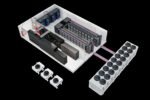In today’s digital-first world, computers and laptops have never been more indispensable in our personal and professional life. As technological advancements unfold at unprecedented pace, there is now a widespread expectancy among consumers for traditional issues such as lag time, slow booting, and substandard performance to be addressed in their entirety. However, computers and laptops may experience significant slowdowns and performance problems, even today.
Kingston Technology is calling on consumers across segments to consider their options when such instances arise, pointing out the benefits of looking at other ways to improve and upgrade performance rather than buying new devices.
Given today’s economic climate and related factors including inflation, increasing prices, and the cost-of-living crisis impacting the wider global community, Kingston Technology is raising awareness surrounding its ‘Upgrade It, Don’t Replace It’ approach, shedding light on the importance of PC upgrade to boost productivity.
“Although demands for the latest innovations have never been higher, purchasing new PC or laptop devices is a luxury some may wish to avoid at present due to turbulent economic conditions,” explained Antoine Harb, Team Leader, Middle East, Kingston Technology. “Rather than replacing hardware when performance wanes, consumers can upgrade their current systems and optimize them, thereby prolonging their use with a ‘brand new’ feel. This is a viable, cost-effective avenue for solving emerging or persisting issues. End-users will continue enjoying the workflows they are accustomed to without replacing systems, which ultimately represents a prudent short-to-midterm investment.”
Whether it be enterprises, SMEs, gamers, or everyday consumers, Kingston Technology highlights that memory and storage upgrades are prudent ways to maximize the performance of existing systems. While many believe memory and storage have the same effect, they have varying roles within computers and the company stresses it is important to first know the difference.
Memory, also known as DRAM (Dynamic Random Access Memory), is where information is constantly being processed and computers utilize RAM for immediate purposes, such as working on applications, editing documents, or opening emails, although DRAM is only accessed on a short-term basis and information is lost if not saved. Storage, meanwhile, is either the hard-disk drive (HHD) or the solid-state drive (SSD) where data is recorded and stored indefinitely. Computers use storage to hold operating systems, applications, and data that can be accessed on a long-term basis.
“Higher capacities of memory and storage come with several valuable benefits for consumers. Besides cost-efficiency, these upgrades overcome vulnerabilities, enhance device security, boost performance, empower users to choose the right level of capacity for their needs, and ensure they keep up with the latest software developments,” continued Harb. “Various solutions are available for consumers to immediately begin availing these outcomes and this is particularly relevant for enterprises, which generally have a three-year refresh cycle and purchased laptops at the beginning of the COVID-19 pandemic to support remote working in early 2020. Again, upgrading is a viable option as opposed to purchasing new systems.”
“Upgrading memory with NVMe solutions is a pre-requisite for efficient use of applications, increasing performance, avoiding sudden system crashes, and more. Alternatively, upgrading storage via SSD can enhance performance with superior power efficiency, faster speed, greater responsiveness, and more space for essential files. We therefore urge consumers from every segment to explore the upgrade options available to them before replacing their hardware without prior consultation.” added Harb.











